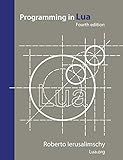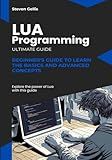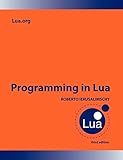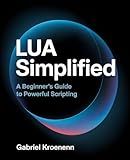Best Lua Programming Guides to Buy in November 2025

Programming in Lua, fourth edition



Coding with Roblox Lua in 24 Hours: The Official Roblox Guide (Sams Teach Yourself)



Lua Programming: Beginner's Guide to Learn the Basics and advanced Concepts



Code Gamers Development: Lua Essentials: A step-by-step beginners guide to start developing games with Lua



Lua: Lua Programming, In 8 Hours, For Beginners, Learn Coding Fast: Lua Language, Crash Course Textbook & Exercises



Programming in Lua
- AFFORDABLE PRICES FOR QUALITY PRE-OWNED BOOKS.
- ECO-FRIENDLY CHOICE: REDUCE WASTE, RECYCLE KNOWLEDGE.
- DETAILED CONDITION GRADING ENSURES CUSTOMER SATISFACTION.



Lua Simplified: A Beginner's Guide to Powerful Scripting



Programming in Lua, Second Edition
- QUALITY ASSURANCE: THOROUGHLY INSPECTED FOR GOOD CONDITION.
- AFFORDABLE PRICING: SAVE BIG ON YOUR FAVORITE TITLES!
- ECO-FRIENDLY CHOICE: PROMOTE SUSTAINABILITY BY RECYCLING BOOKS.


To read and write a file in Lua, you can follow these steps:
- Open an existing file or create a new file using the io.open(filename, mode) function. The filename parameter is the name or path of the file, and the mode parameter specifies the file mode, such as "r" for reading or "w" for writing.
- To read from a file, use the file:read(format) function, where file is the file object returned by io.open() and format specifies the format of the data to be read. For example, you can use "*a" to read the entire file, "*l" to read a line, or "*n" to read a number.
- To write to a file, use the file:write(data) function, where file is the file object and data is the content you want to write. You can pass multiple arguments to write() for writing multiple strings or values.
- After reading from or writing to the file, close it using the file:close() function.
Here is a simple example that demonstrates reading from and writing to a file:
-- Open the file in read mode local file = io.open("myfile.txt", "r")
-- Read the entire content of the file local content = file:read("*a")
-- Print the content print(content)
-- Close the file file:close()
-- Open the file in write mode file = io.open("myfile.txt", "w")
-- Write some data to the file file:write("Hello, Lua!")
-- Close the file file:close()
In the above example, myfile.txt is opened in read mode first, and its content is read and printed. Then the file is closed. Next, the file is opened again in write mode and the string "Hello, Lua!" is written to it. Finally, the file is closed again.
Remember to handle any potential errors that may occur during file operations using appropriate error checking and exception handling mechanisms.
How to iterate through all lines of a file in Lua?
To iterate through all lines of a file in Lua, you can use the io.lines() function combined with a for loop. Here's an example:
-- Open the file in read mode local file = io.open("path/to/file.txt", "r")
if file then -- Iterate through each line in the file for line in file:lines() do -- Process each line here print(line) end
-- Close the file after processing
file:close()
else print("Failed to open the file") end
In this example, change "path/to/file.txt" to the actual path of the file you want to read. The io.lines() function returns an iterator over the lines of the file, and the for loop iterates through each line. Replace print(line) with your own code to process each line according to your requirements. Finally, remember to close the file using file:close() after you're done reading it.
How to create a new file in Lua?
To create a new file in Lua, you can use the io.open function. Here is an example code:
local file = io.open("filename.txt", "w") -- "w" mode opens the file in write mode
if file then file:write("Hello, World!\n") -- Write content to the file file:close() -- Close the file print("File created successfully.") else print("Failed to create file.") end
Here, io.open takes two parameters: the filename (including the path if necessary) and the mode. The available modes are "r" (read mode), "w" (write mode), "a" (append mode), and "b" (binary mode).
Using the file:write function, you can write content to the file. Remember to close the file using file:close() to release system resources.
The above example creates a new file called filename.txt, writes "Hello, World!" to it, and closes the file. If the file creation is successful, it prints "File created successfully." Otherwise, it prints "Failed to create file."
How to read a specific line from a file in Lua?
To read a specific line from a file in Lua, you can use the following code:
-- Open the file in read mode local file = io.open("file.txt", "r")
-- Loop through each line in the file local lineNumber = 1 for line in file:lines() do -- Check if it's the desired line number if lineNumber == 3 then -- Print or use the line as needed print(line) -- Or store it in a variable break end
lineNumber = lineNumber + 1 end
-- Close the file file:close()
In this example, the file "file.txt" is opened in read mode using io.open("file.txt", "r"). Then, a loop is used to iterate through each line in the file. The lineNumber variable keeps track of the current line being processed. When the desired line (in this case, line number 3) is reached, you can print or use the line as required. Finally, after reading the line, the file is closed using file:close() to free up system resources.
Make sure to update the file name and line number according to your specific requirements.
How to read and write files using absolute paths in Lua?
To read and write files using absolute paths in Lua, you can use the io.open function. Here's an example of how you can achieve this:
- Setting the absolute path:
local absolutePath = "C:/path/to/file.txt" -- Replace this with your actual absolute path
- Reading a file:
-- Open the file in read mode local file = io.open(absolutePath, "r")
if not file then -- File could not be opened, handle the error print("Could not open the file:", absolutePath) else -- Read the contents of the file local content = file:read("*all")
-- Print the contents print(content)
-- Close the file file:close() end
- Writing to a file:
-- Open the file in write mode local file = io.open(absolutePath, "w")
if not file then -- File could not be opened, handle the error print("Could not open the file:", absolutePath) else -- Write content to the file file:write("Hello, Lua!")
-- Close the file file:close() end
Make sure to replace "C:/path/to/file.txt" with the actual absolute path of the file you want to read or write.
What is Lua?
Lua is a lightweight, high-level programming language designed primarily for embedded systems and scripting purposes. It was created in 1993 by a team of Brazilian developers and has gained popularity for its simplicity, efficiency, and extensibility. Lua is often used as an embedded scripting language in various applications and game development frameworks, such as World of Warcraft, Adobe Photoshop Lightroom, and Roblox. It supports procedural, object-oriented, and functional programming paradigms and provides a wide range of standard libraries. Additionally, Lua is known for its easy integration with other languages and its ability to act as a glue language, allowing developers to combine different components written in different languages.
Can Lua handle different file formats like text, CSV, or XML?
Yes, Lua can handle different file formats such as text, CSV, or XML. While Lua does not have built-in libraries specifically for handling these file formats, it provides options for reading and writing files.
For handling text files, Lua's standard I/O library provides functions like io.open() for reading and writing text files. You can use functions like file:read() and file:write() to handle text data.
For CSV files, Lua has various community-developed libraries available, such as "LuaCSV" and "lua-csv". These libraries provide functions to read and parse CSV files, allowing you to work with the data in Lua.
For XML files, Lua provides "LuaExpat," a popular library for parsing XML. "LuaXML" is another XML library that can also parse XML documents. These libraries allow you to access XML data and manipulate it using Lua.
Overall, while Lua might require external libraries for handling specific file formats like CSV or XML, it is flexible enough to provide solutions for working with different file formats.
